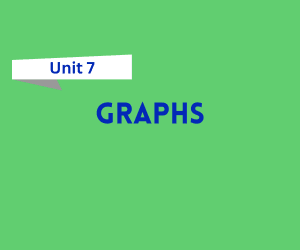
Free Download Graphs Notes in pdf – Bca 3rd Semester. High quality, well-structured and Standard Notes that are easy to remember.
Click on the Download Button 👇
Graphs: Description, Key Points, and Features
A graph is a fundamental data structure in computer science and discrete mathematics, used to represent relationships between pairs of objects. Graphs consist of a set of vertices (also called nodes) and a set of edges (also called arcs) that connect pairs of vertices. Graphs can be used to model a wide variety of systems such as social networks, communication networks, transportation systems, and many more.
Description
In a formal definition, a graph G is defined as an ordered pair G = (V, E), where:
- V is a set of vertices (nodes).
- E is a set of edges (links between vertices), where each edge connects two vertices.
Graphs can be classified into different types based on their structure:
- Directed vs. Undirected Graphs: In a directed graph (digraph), each edge has a direction, meaning it points from one vertex to another. In an undirected graph, edges do not have directions, and the connection is bidirectional.
- Weighted vs. Unweighted Graphs: In a weighted graph, edges have weights or costs associated with them, often representing distance, time, or cost. In an unweighted graph, all edges are considered equal.
- Cyclic vs. Acyclic Graphs: A cyclic graph contains one or more cycles (a path of edges and vertices where a vertex is reachable from itself). An acyclic graph contains no cycles.
- Connected vs. Disconnected Graphs: In a connected graph, there is a path between every pair of vertices. In a disconnected graph, some vertices are not reachable from others.
Key Points
Graph Representation:
- Adjacency Matrix: A 2D array where each element indicates whether a pair of vertices is connected by an edge. For an undirected graph, the matrix is symmetric, and in the case of a directed graph, the matrix is asymmetric.
- Adjacency List: A more space-efficient representation, especially for sparse graphs. It consists of a list of all vertices, where each vertex points to a list of its neighboring vertices.
- Edge List: A simple list of all edges in the graph, often used for edge-centric operations like shortest path algorithms.
Graph Traversal:
- Depth-First Search (DFS): A traversal algorithm that starts at a source node and explores as far along each branch as possible before backtracking. DFS is implemented using a stack (either explicitly or via recursion).
- Breadth-First Search (BFS): A traversal algorithm that explores all neighbors of a vertex before moving to the next level of vertices. It uses a queue for its implementation. BFS is useful for finding the shortest path in unweighted graphs.
Applications of Graphs:
- Shortest Path Algorithms: Graphs are widely used to find the shortest path between nodes. For example, Dijkstra’s Algorithm is used for weighted graphs, while BFS can be used for unweighted graphs.
- Minimum Spanning Tree (MST): For a weighted, undirected graph, algorithms like Kruskal’s or Prim’s can be used to find the minimum spanning tree, a subgraph that connects all the vertices with the least possible total edge weight.
- Cycle Detection: DFS can be used to detect cycles in both directed and undirected graphs, helping in applications like deadlock detection in operating systems.
- Graph Coloring: Assigning colors to the vertices of a graph so that no two adjacent vertices share the same color. This is useful in problems like scheduling.
Graph Algorithms:
- Dijkstra’s Algorithm: Finds the shortest path from a source vertex to all other vertices in a weighted graph.
- Bellman-Ford Algorithm: Handles graphs with negative edge weights and detects negative weight cycles.
- Kruskal’s and Prim’s Algorithms: Both find the Minimum Spanning Tree of a graph, used in optimizing networks and resource allocation.
Features
Flexibility: Graphs are versatile structures that can model many real-world relationships, such as transportation networks, electrical circuits, social media connections, and even computer networks.
Graph Traversal Algorithms:
- Depth-First Search (DFS): Efficient for exploring the depth of a graph, making it useful for applications like solving mazes or puzzles.
- Breadth-First Search (BFS): Optimal for finding the shortest path in unweighted graphs and solving connectivity problems.
Space Complexity: Graphs can be represented using different methods depending on the application’s memory requirements:
- Adjacency Matrix requires O(V²) space, where V is the number of vertices. It is suitable for dense graphs.
- Adjacency List requires O(V + E) space, where E is the number of edges. It is more space-efficient for sparse graphs.
Time Complexity:
- Graph Traversal (DFS, BFS): These algorithms have a time complexity of O(V + E), meaning the time required grows linearly with the number of vertices and edges.
- Shortest Path Algorithms: The time complexity of Dijkstra’s algorithm is O(E + V log V) when using a priority queue, while Bellman-Ford runs in O(VE) time.
Applications in Real-World Problems:
- Social Networks: Graphs represent users as vertices and friendships or interactions as edges.
- Network Routing: Graph algorithms like Dijkstra’s and Bellman-Ford are used in routing protocols to find the best path between nodes in a network.
- Recommendation Systems: Many recommendation systems (e.g., those used by e-commerce platforms) utilize graph algorithms to find connections between users and items.